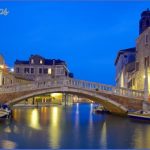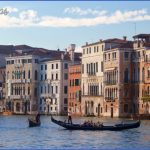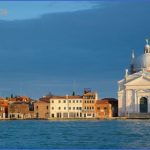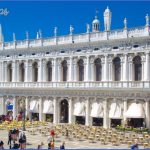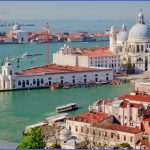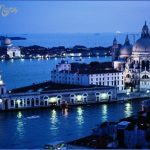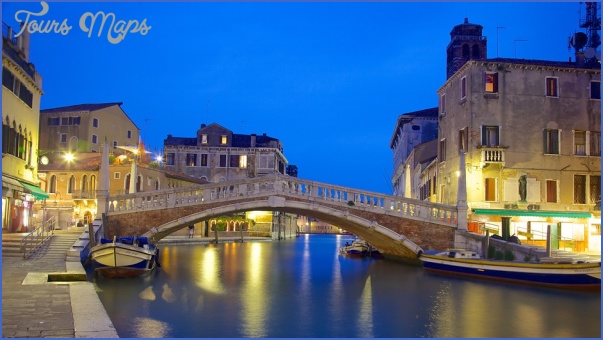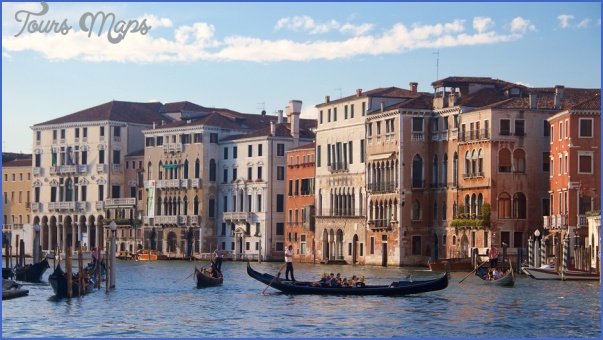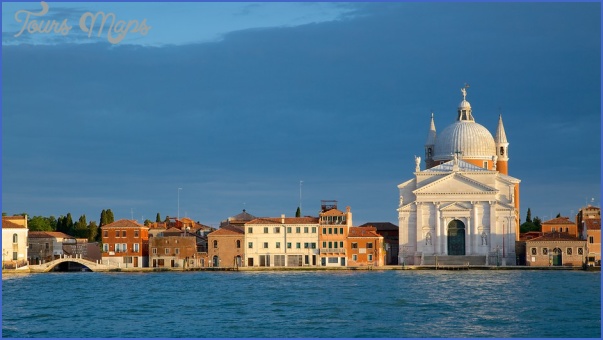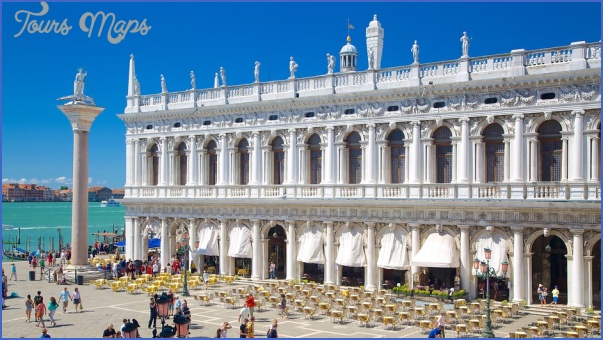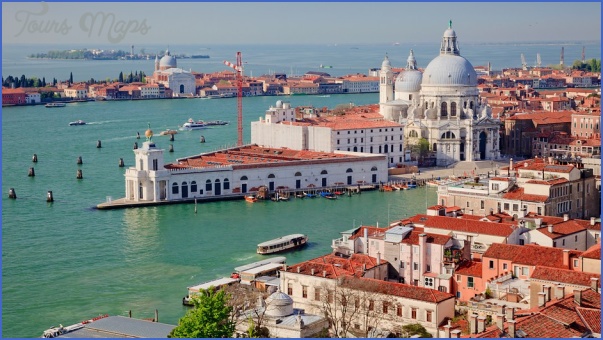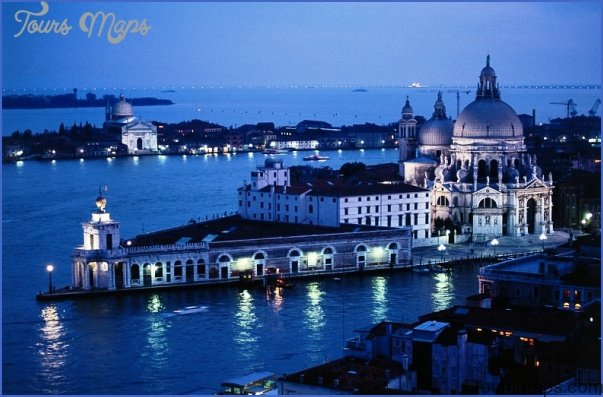Venice Vacations
AROUND THE PONTE RIALTO
THE GRAND CANAL. The Grand Canal is Venice’s main street. Over 3km long and nearly 50m wide, it loops through the city and passes under three bridges: the Ponte Scalzi, Rialto, and the Ponte Accademia. Coursing past the splendid facades of the palazzi that crown its banks, it is a testament to Venice’s history and immense wealth. The candy-cane posts used for mooring boats on the canal are called bri- cole; they are painted with the family colors of the adjoining palazzo. (For great facade views, ride vaporetto #82 or the slower #1 from the train station to P.S. Marco. The facades are flood-lit at night, producing a dazzling play of reflections.)
PONTE RIALTO. This impressive architectural construct was named after Rivo Alto, the first colony built in Venice. It was originally built of wood, but after its collapse in the 1500s, Antonio da Ponte designed the current stone structure (1588-91). Today, shops and vendors crowd the top of the bridge.
RIVOALTUS LEGATORIA. Step into Rivoaltus on any given day and hear Wanda Scarpa shouting greetings from the attic, where she has been sewing leather- bound antique style journals for more than three decades. This delightful and reasonably priced shop, run by arguably the nicest husband and wife tandem in Italy, is cluttered with the results of her diligent toiling. Giorgio Scarpa jokes that he chains her there to make her work. Though Venice is now Uttered with shops advertising handmade journals, Rivoaltus was the first, and sells products of such renowned quality that even movie stars have been known to send their agents specifically to this shop to buy portfolios. Come in for a friendly chat and ask Giorgio for a tour of the shop. (Ponte di Rialto. Open daily 10am-7:30pm.)
SAN POLO Venice’s most illustrious scuola, or guild hall, stands as a monument to Jacopo Tintoretto. The painter, who left Venice only once in 76 years (and refused to take that trip without his wife), set out to combine the color of Titian with the drawing of Michelangelo. The school commissioned Tintoretto to complete all the paintings in the building, which took 23 years. The Crucifixion in the last room upstairs is the collection’s crowning glory. Step outside to admire this masterpiece to classical music performed on the street. (Behind Basilica dei Frari in Campo S. Rocco. Open daily 9:30am-5:30pm. ‚5.50, students ‚4.)
CAMPO SAN POLO. The next-largest campo in Venice after P.S. Marco, Campo San Polo once hosted bull-baiting matches. During the carnevale, authorities would release a wild bull into the crowds, then set dogs on its tail. After the dogs began to tear the bull’s flesh, the defeated animal would finally be decapitated before a hooting, jeering mob. A painting depicting the ensuing chaos hangs in the Museo Correr in P.S. Marco. Today, the campo is filled with benches, trees, and frolicking children, so visits are rather less intense. (Between the Ponte Frari and Ponte Rialto. Vaporetto: S. Silvestm.)
GALLERIE DELL’ACCADEMIA. The Accademia houses the most extensive collection of Venetian art in the world. At the top of the double staircase, Room I, topped by a ceiling full of cherubim, houses Venetian Gothic art, with a luxurious use of color that influenced Venetian painting for centuries. Among the enormous altarpieces in Room II, Giovanni Bellini’s Madonna Enthroned with Child, Saints, and Angels stands out for its lush serenity. Rooms IV and V display more Bellinis and Giorgione’s enigmatic La Tempesta. In Room XX, works by Gentile Bellini and Carpaccio display Venetian processions and city- scapes so accurately that scholars use them as photos of Venice’s past. (Vaporetto: Accademia. Open M 8:15am-2pm, T-Su 9:15am-7:15pm. ‚6.50.)
COLLEZIONE PEGGY GUGGENHEIM. Guggenheim’s Palazzo Venier dei Leoni now displays works by Brancusi, Marini, Kandinsky, Picasso, Magritte, Rothko, Ernst, Pollock, and Dali. The Marini sculpture Angel in the City, in front of the palazzo, was designed with a detachable penis. Guggenheim occasionally modified this sculpture so as not to offend her more prudish guests. (Calle S. Chstoforo, Dorsoduro 710. Vaporetto: Accademia. Turn left and follow the yellow signs. Open Su-M and W-F 10am-6pm, Sa lOam-lOpm. ‚8, ‚5 with Rolling Venice card.)
CA REZZ0NIC0. Longhena’s great 18th-century Venetian palace houses the newly restored Museo del Settecento Veneziano (Museum of 18th-Century Venice). Known as the Temple of Venetian Settecento, this grand palace features a truly regal ballroom, complete with flowing curtains and Crosato’s frescoed ceiling depicting Phoebus with the continents. (Vaporetto: Ca Rezzonico. Reserve 24hr. ahead. 043 241 01 00. Open Apr.-Oct. M and W-Su 10am-6pm, Nov.-Mar. 10am-5pm. ‚6.50, students and Rolling Venice card holders ‚4.50.)
SCUOLA DALMATA SAN GIORGIO DEGLI SCHIAVONI. Some of Carpaccio’s finest paintings, including episodes from the lives of St. George, Jerome, and Tryfon, decorate this early 16th-century building. (Castello, 3259A. Vaporetto: S. Zaccaria. Modest dress required. Open Apr.-Oct. Su 9:30am-12:30pm, Tu-Sa 9:30am-12:30pm and 3:30- 6:30pm; Nov.-Mar. Su 10am-12:30pm, Tu-Sa 10am-12:30pm and 3-6pm. ‚3.)
Venice Vacations Photo Gallery
Maybe You Like Them Too
- Explore the Beautiful City of Southport, Australia with This Map
- Explore Sasbach, Germany with our Interactive Map
- Explore Nevestino, Bulgaria with this Detailed Map
- Explore Pulau Sebang Malaysia with this Detailed Map
- Explore Southgate, Michigan with this detailed map

